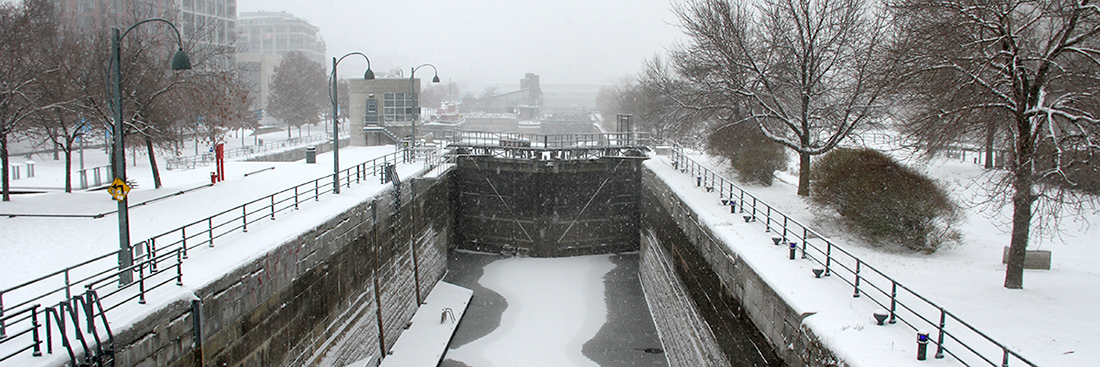
Why lower the canal water?
Lachine Canal National Historic Site
The canals for which Parks Canada is responsible are national historic structures. As manager of the sites, the Agency operates the canals and performs conservation work on their infrastructures. These investments in the preservation, rehabilitation and restoration of national historic sites help to protect our heritage and strengthen their appeal as destinations to celebrate our nation’s achievements.
Infrastructure maintenance
It is primarily for maintenance and restoration purposes that Parks Canada must occasionally empty the Lachine Canal. Lowering the water allows technicians to examine and perform maintenance on components that are key to safely operating the locks.
A delicate operation
In most cases, we lower the canal water right after the navigation season, in October. In general, we avoid leaving the canal empty during the winter, as the body of water alone plays a key role in maintaining the canal. In fact, the body of water makes it possible to offset the force exerted by the earth on the walls outside the foundations of the canal, particularly in freezing conditions. However, since 2017, the canal has had to remain empty during the winter for extensive rehabilitation work on its walls.
A huge undertaking
Making millions of cubic metres of water disappear is no small feat! First, all wharves attached to walls in the lock chambers and along the canal must be removed. Then, we open the valves one at a time, starting with the lock furthest downstream and moving toward the lock furthest upstream. Emptying the Lachine Canal can take two to three days!
What about the fish?
It’s the major question we all ask ourselves when we undertake this type of operation. Rest assured that most fish pass through the valves of the locks and reach the river. However, some of them may get caught in pockets of water, which are generally deep enough to ensure their survival through winter. When a section of the Canal is completely dry, the Parks Canada environmental teams get involved by collecting fish and releasing them into the nearest watercourse, as seen in the video below filmed at Chambly Canal.
Fish recrue at Chambly Canal
Transcript
Parks Canada logo
Close up (CU) of an employee attaching a metal clip to his safety harness
Today we are rescuing and moving fish from lock 6 of the Chambly Canal.
Panning shot of the site next to the lock, a group of people are talking/meeting
Medium Shot (MS) shot of Parks Canada employee speaking
Interventions such as this one are very important to the repair work at the locks.
MLS of Parks Canad employee talking with the lock in the background behind her - Text Graphic appears " Karine Lalonde; Environmental assessment agent, Parks Canada"
This is part of the environmental mitigation measures that are being put in place ...
Crane being backed-up
to complete the work with minimal impact on the environment.
Long shot of employees observing the crane being set in place
Shot of two books laying in the grass (The book is on fish)
Long shot of an employee climbing down the ladder into the lock
The majority of fish succeeded in leaving the lock when the canal was lowered.
Medium Shot (MS) shot of Parks Canada employee speaking
There are approximately one to two feet of water remaining, and there are fish in the lock bottom.
Shot of container being lowered into the lock
High angled shot of a worker pulling out a bin from the container
To move the fish, COVABAR was called in [committee for consultation on and development of the Richelieu River basin]
High angeled shot of worker taking out a net
Long shot (LS) of the worker moving the net around the lock
They descended to the lock bottom, they used a large stage, they also have dip nets to retrieve the fish.
MCU of employee pulling on the net
Above shot on the net moving through the water in the lock - moving left to right
Close up of the water collected being filtered, through to use of a fish net
Shot of employee pick out each fish by hand and placing them inside a bin
Long shot (LS) of 2 employees looking inside of the bin from the container, with the locks walls as the background
The fish are put in bins, and the bins are brought back up using a boom truck.
MS of two employees pulling out fish from the net and palcing them in the bins
Another shot of the same action (placing fish into the bins)
Close up of employee closing the bin
Shot of container being lifted out of the lock
Shot of container being replaced on the ground outside of the lock
The bin of fish that were retrieved from the lock was just put in a truck
MCU of Karine is sitting in the drivers seat, talking to us
...that is now on the way to the Chambly Basin where the fish will be released.
Shot of pick-up truck driving away
Shot of the lake
High angled shot of Parks employees pourring out the bin into the lake
Go Pro shot underwater of a fish swimming
"Shot of fish moving around in the water. Text appears ""2,652 fish identified in locks 6 and 7 21 species observed and relocated""
"Visit Parks Canada's website to learn more about the fauna of the Chambly Canal.
Parks Canada
"Her Majesty the Queen in Right of Canada represented by Parks Canada, 2017
"Logo of Canada
- Date modified :